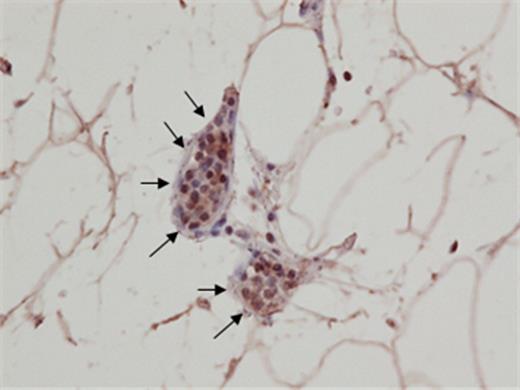Abstract
Abstract 5104
Intravascular large B-cell lymphoma (IVLBCL) is a rare disease entity of malignant lymphoma, characterized by the selective growth of lymphoma cells within the lumina of vessels in various organs. Although recent reports showed that prompt and accurate diagnosis lead to better outcomes, absence of typical clinical manifestations and its aggressive behavior frequently makes it difficult. LR11 (also called SorLA or SORL1) is a type I membrane protein, from which a soluble form (sLR11) is released by proteolytic shedding. sLR11 is originally known to be a biomarker of carotid intima-media thickness. We have recently found that LR11 is expressed on human leukemia cell lines, and sLR11 is released in its culture medium. Serum sLR11 levels are significantly elevated in patient serum samples with acute leukemia and B cell lymphomas, and are associated with tumor burden and bone marrow invasion. Based on these findings, we hypothesized that LR11 may be also expressed and released from IVLBCL cells; therefore we evaluated its clinical importance in IVLBCL.
Serum samples and paraffin embedded tumor specimens were obtained from 6 patients who were histologically diagnosed as IVLBCL from 2009 to 2012. Specimens were subjected to immunostaining using anti-LR11 antibody, and serum sLR11 levels were measured by ELISA method. Patient laboratory and clinical data were collected retrospectively. Also, serum samples from 75 healthy volunteers, and 10 patients with collagen diseases presenting similar clinical manifestations as IVLBCL were analyzed.
Tissue samples of IVLBCL were obtained by bone marrow biopsy (N=2), transbronchial lung biopsy (N=2), and random skin biopsy (N=2). Biopsy specimens showed that cytoplasm of IVLBCL cells were specifically immunoreacted against the anti-LR11 antibody (Figure 1). Median serum sLR11 level of IVLBCL patients was 86. 0 ng/ml (mean ± SD: 201. 8 ± 260. 0 ng/ml), which was significantly elevated than those of healthy volunteers (median: 8. 4 ng/ml, mean±SD: 8. 8 ± 1. 8 ng/ml, p<0. 0001) and patients with collagen diseases (median: 14. 4 ng/ml, mean ± SD: 15. 9 ± 5. 9 ng/ml, p<0. 0001). Paired sample analysis showed that elevated sLR11 levels at disease diagnosis were decreased to normal range when disease remission was achieved (median: 13. 3 ng/ml, mean ± SD: 11. 0 ± 3. 3 ng/ml).
We have identified LR11 as a novel molecule which was proven to be expressed in IVLBCL cells and circulated in patients' serum. LR11 immunostaining clearly highlights the tumor cells and sLR11 enables to distinguish IVLBCL from other differential diagnosis by serum evaluation. These findings suggest that LR11 is a useful diagnostic tool for IVLBCL, and serum sLR11 is a sensitive biomarker for diagnosis and disease monitoring of this challenging disease.
Immunostaining of transbronchial lung biopsy tissue for anti-LR11 antibody, showing LR11-positive lymphoma cells (arrow) increasing in lumina of small vessels.
Immunostaining of transbronchial lung biopsy tissue for anti-LR11 antibody, showing LR11-positive lymphoma cells (arrow) increasing in lumina of small vessels.
No relevant conflicts of interest to declare.
Author notes
Asterisk with author names denotes non-ASH members.


